The Importance of the Long Slow Run - MAF, Run-Walk or Zone 1 or 2
 Karen Parnell
December 21, 2021
Karen Parnell
December 21, 2021
The Importance of the Long Slow Run

Every triathlete needs to get to grips with their long run every week. If you are training for a sprint distance or an IRONMAN event your will need to go for a long run to make the necessary body adaptations for your race. The key is to build your aerobic base and not get injured.
It’s been shown that most injuries for triathletes occur during run training. Aerobic training is the foundation of endurance training. Aerobic fitness takes time to improve, there are no shortcuts, no nutritional or supplement silver bullets. The aerobic system provides 90%+ of the energy for endurance sports over 20 minutes and 98% for 8-hour+ events. 80% to 85% of your training should be in this zone.
A good aerobic base isn’t only important for endurance athletes. The system that controls the body’s stress response is functionally linked to the anaerobic system. In other words, if you depend too much on your anaerobic system, you’ll be more stressed, and therefore more likely to over-train or become injured. There are a number of strategies you can employ to help prevent injuries – warm up well, run in a controlled manor with good running form and warm down at the end of your run.

Photo by Frank Cone
Get your FREE guide to Running Technique
MAF 180 Method
Dr. Philip Maffetone developed a run method which is based on running at 180-age heart rate, so you will need a heart rate (HR) monitor for this training method. For MAF based running simply take 180 minus your age.
That figure is the heart rate you should be running at to improve your aerobic based. This may mean walking at some points during your run to bring your HR down below your max MAF HR. Initially, training at this relatively low rate may be difficult for some athletes. “I just can’t train that slowly!” is a common comment. But you will need to trust the process.
But after a short time, you will feel better and your pace will quicken at that same heart rate. You will not be stuck training at that relatively slow pace for too long. Still, for many athletes it is difficult to change bad habits – be patient. Doing a regular simple MAF test every 6 weeks or so will show if you are going in the right direction.
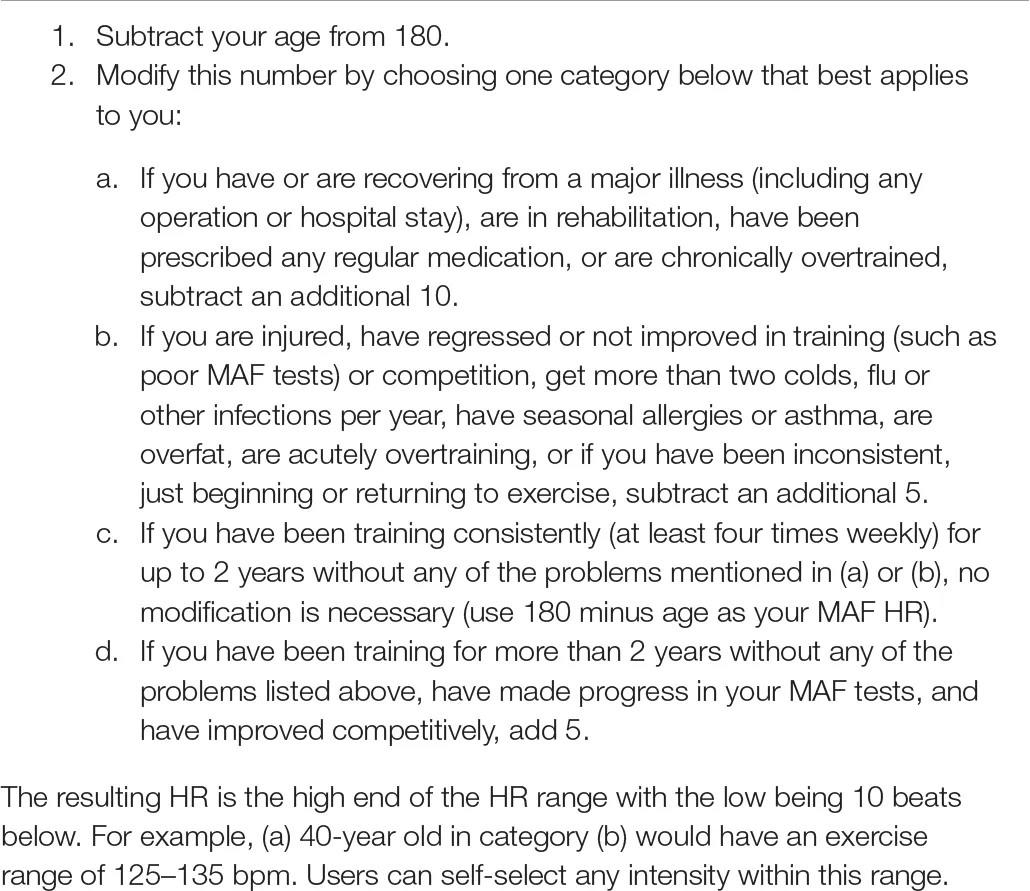
The MAF Test should indicate faster times as the months go by. This means the aerobic system is developing and you’re burning more fat, enabling you to do more work with the same effort. Even if you walk or run longer distances, your MAF Test should show the same progression of results, providing you heed your maximum aerobic heart rate (180-age). Training sessions are in minutes rather than distance.
For example, run at your MAF heart rate for 45 minutes, how far did you go?
Over time the distance you will cover will increase as your body adapts and you walk less. This is a great way to test improvement.
You can calculate your MAF heart rate zones using the ChiliTri MAF Heart Rate Calculator.
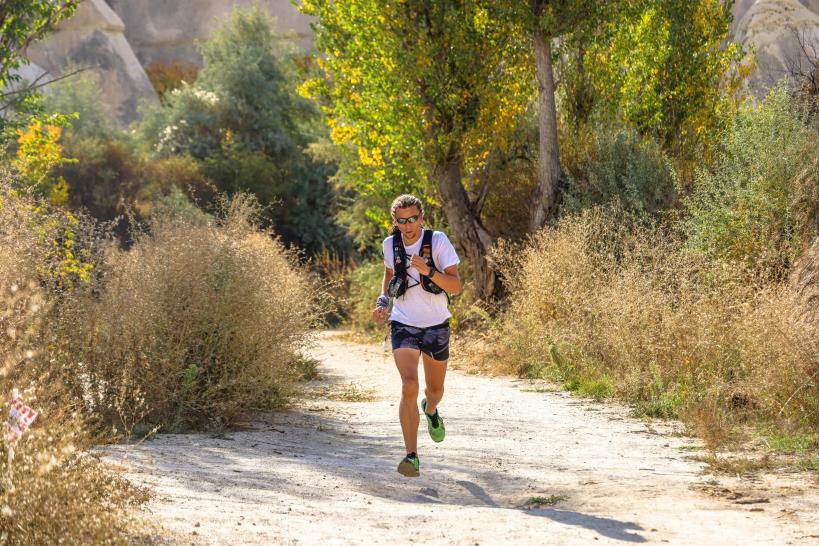
Photo by Emrah Yazıcıoğlu
Just getting started? Here's a FREE Trail Running Plan
Walk-Run Method or "Jeffing"
Another popular method was developed by Jeff Galloway the run-walk-run method.
The run-walk method is very simple: Run for a short segment and then take a walk break--and keep repeating this pattern. Beginners will alternate very short run segments with short walks. Even elite runners find that walk breaks on long runs allow them to recover faster.
You will need a stopwatch for this method.
An example for a 10 min mile pace would be run for 3 minutes and walk for 1 minute and repeat over the distance.
Example Walk-Run Training Cycles Based on Mile Times
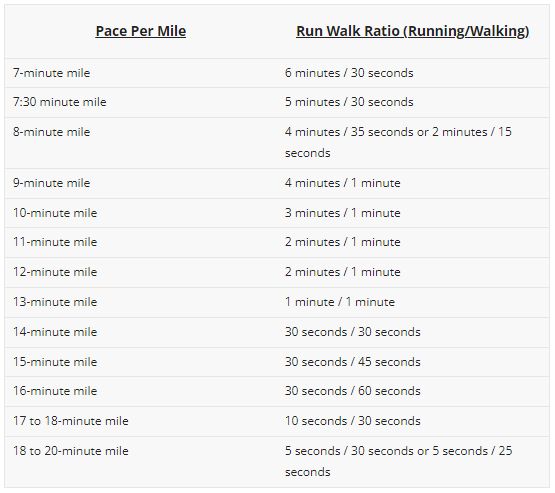
The benefits of Walk breaks:
• Give you control over the way you feel
• Erase fatigue
• Allow endorphins to collect during each walk break -- you feel good
• Break up the distance into manageable units ("I can go for two more minutes")
• Speed recovery
• Reduce the chance of aches, pains and injury
• Allow you to feel good afterward--carrying on the rest of your day without debilitating fatigue
• Give you all the endurance of the distance of each session--without the pain
• Allow older or heavier runners to recover fast, and feel as good or better than the younger (slimmer) days
Download your FREE 8-Week Trail Running Training Plan.
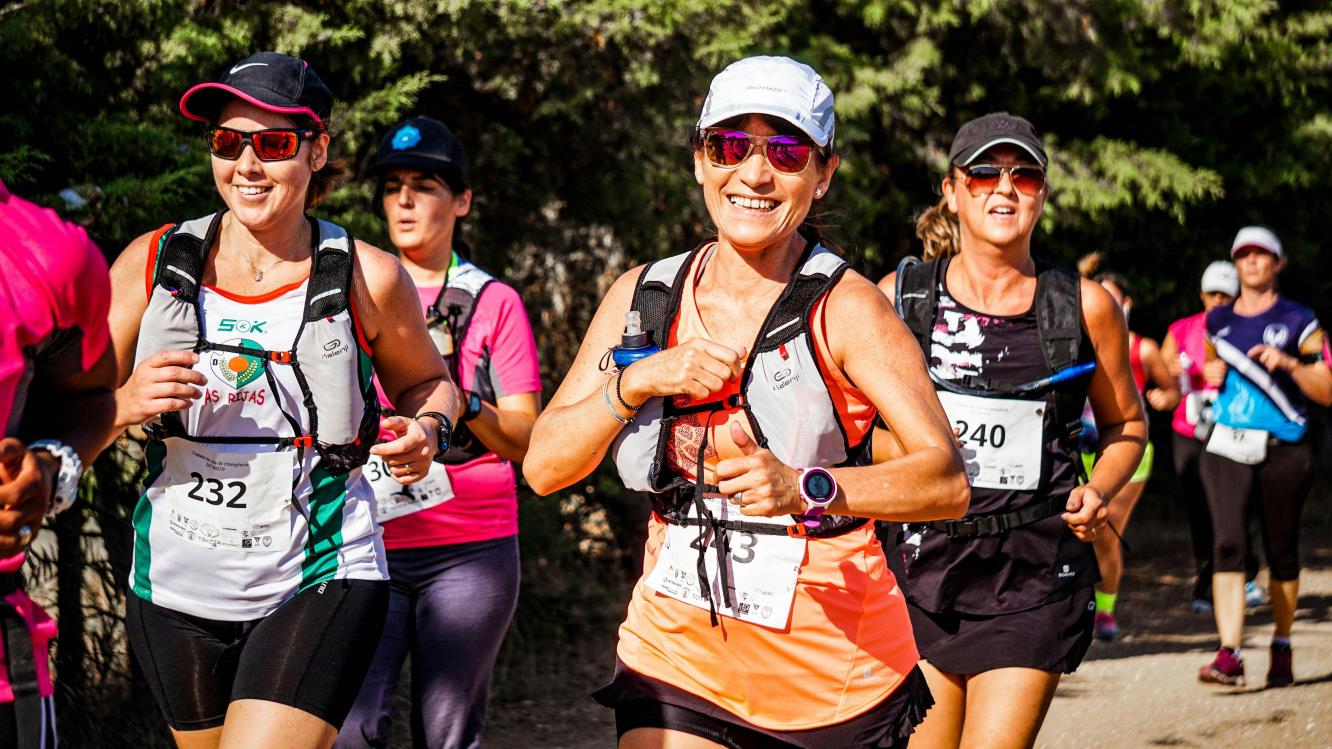
Get your FREE guide to Running Technique
Zone 1 or 2 Running
Zone 1/2 is a very low intensity. Staying within it usually requires that you actively hold yourself back to a pace that’s slower than your natural running pace or even walk until your body adjusts to this low zone. The common exception is when a Zone 1 recovery jog follows a tiring high-intensity effort. The important thing to understand is that it’s almost impossible to go too slow when you’re aiming for Zone 1, whereas it’s very easy and all too common to go too fast.
Why run in Zone 1?
Zone 1 and 2 training is important because the of benefits of these workouts. You build endurance, durability and strength. In addition, these easy training sessions help build capillary pathways that transport oxygen to your muscles and carry waste (lactate) away from your muscles. Plus you reduce your risk of injury.
The Science behind Z1 or 2 Running
In this training zone we stimulate Type 1 muscle fibers, therefore we stimulate mitochondrial growth and function which will improve the ability to utilize fat. This is key in athletic performance as by improving fat utilization we preserve glycogen utilization throughout the entire competition. Athletes can then use that glycogen at the end of the race when many competitions require a very high exercise intensity and therefore a lot of glucose utilization.
Besides fat utilization, type I muscle fibres are also responsible for lactate clearance. Lactate is the byproduct of glucose utilization which is utilized in large amounts by fast twitch muscle fibres. Therefore, lactate is mainly produced in fast twitch muscle fibres which then, through a specific transporter called MCT-4, export lactate away from these fibres.
However, lactate needs to be cleared or else it will accumulate. This is when Type I muscle fibres play the key role of lactate clearance. Type I muscle fibres contain a transporter called MCT-1 which are in charge of taking up lactate and transporting it to the mitochondria where it is reused as energy. Zone 1/2 training increases mitochondrial density as well as MCT-1 transporters. By training Zone 1/2 we will not only improve fat utilization and preserve glycogen but we will also increase lactate clearance capacity which is key for athletic performance.
An endurance athlete should never stop training in zone 1/2. The ideal training plan should include 3-4 days a week of zone 2 training in the first 2-3 months of pre-season training, followed by 2-3 days a week as the season gets closer and 2 days of maintenance once the season is in full blown.
Think of it as a way to build your body's capacity to run faster. When you're running slowly, your body is increasing its mitochondria and capillary production and making it easier for you to run faster the next time you face a hard training run or race. It's laying the groundwork you need to improve as a runner.

Photo by Maksim Goncharenok
Download your FREE 8-Week Trail Running Training Plan.
Warm up before your run (10 mins)
Once you’re ready to run, it’s tempting to shoot out the door at top speed or forego a running warmup in the interest of saving time. But heading out the door at full throttle without a proper pre-run warmup is a recipe for disaster and more likely injury. I like to kill two birds with one stone with the warm-up and not only prepare the mind and body for the run ahead but also do some drills to improve stability, balance, run technique and core strength.
It’s important that any stretches are dynamic before exercise. Dynamic stretches are a bit of a misnomer and sometimes people get confused and hear people saying stretching before exercise is bad. Static stretches have indeed been shown to be not a good way to warm up but moving "stretches" or dynamic movements or drills are necessary to be prepared for the sessions ahead.
These are my favourite running drills and dynamics movements:
1 minute on each
• Hip openers with skip and hip closers with skip
• High Knees
• Butt kicks
• Leg lifts with skip – straight leg soldier march, stretching hamstrings
• Side strides – drive with outer leg
• High skips
• Carioca
• Step Balance T – arms out to form a T
• Step single leg hop with balance
• Strides – slow to fast sprint building pace to 90%
Here's a great running warm up from Leslie Paterson, pro triathlete:
Warm Down after your Run
After your heel raises then complete static stretches to improve your flexibility and range of motion, it can also help your muscles recover faster after a workout, leading to less pain and stiffness or DOMS (delayed onset muscle soreness).
Static stretching is also a great way to release stress and tension in your muscles, which can help you feel more relaxed.
You can also couple this with a foam roller routine.
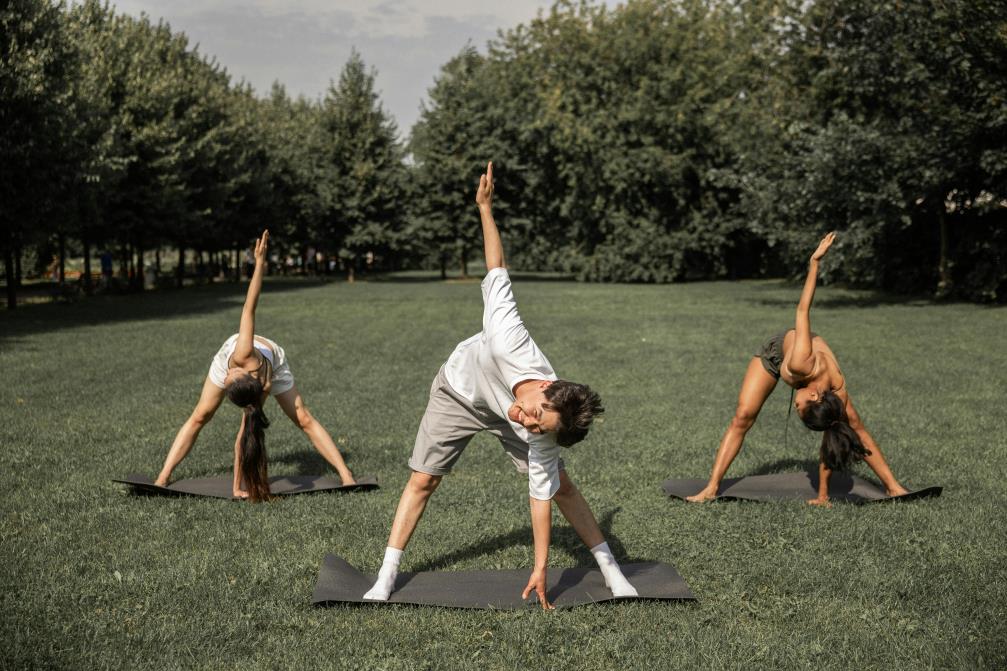
Photo by Monstera Production/
Get your FREE guide to Running Technique
Conclusion: The Advantages of the Slow Run
Whether your goal is to improve your aerobic base or prevent injuries you may need to go slower to get faster. Don’t worry if you have to walk a little during a race or on a long training run as it will pay dividends come race day.
Incorporating long, slow runs into your training regimen is essential for building a robust aerobic base, enhancing endurance, and reducing injury risk. By focusing on methods like the MAF 180 formula or the run-walk approach, you can tailor your workouts to suit your fitness level and goals.
Remember, consistency and patience are key; over time, these runs will lead to improved performance and a more enjoyable running experience. So, lace up your shoes, embrace the journey, and watch as your endurance and resilience grow with each step.
Download your FREE 8-Week Trail Running Training Plan.
Get your FREE guide to Running Technique
Would you like a free training plan? Claim your free plan or e-book.
Karen Parnell is a Level 3 British Triathlon and IRONMAN Certified Coach, 8020 Endurance Certified Coach, WOWSA Level 3 open water swimming coach and NASM Personal Trainer and Sports Technology Writer.
Karen is currently studying for an MSc in Sports Performance Coaching at the University of Stirling.
Need a training plan? I have plans on TrainingPeaks and FinalSurge:
I also coach a very small number of athletes one to one for all triathlon and multi-sport distances, open water swimming events and running races, email me for details and availability. Karen.parnell@chilitri.com
Get your FREE Guide to Running Speed and Technique
Get your FREE Swim Workouts for Triathletes E-book
Get your FREE Open Water Swimming Sessions E-Book

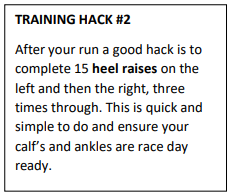
Training Hack: Heel/Calf Raises
FAQ: The benefits of the long slow run (MAF, Run/Walk and Z1/2 training)
Q: What is a long slow run?
A: A long slow run refers to a running session where the primary focus is on covering a longer distance at a relaxed and comfortable pace. It is typically done at a slower pace than other types of runs, such as interval training or tempo runs.
Q: What are the benefits of incorporating long slow runs into a training program
A: Long slow runs offer several benefits for runners:
- Endurance development: The extended duration of a long slow run helps build cardiovascular endurance and increases the body's capacity to sustain effort over long distances. It trains the aerobic system, improving its efficiency in utilizing oxygen for energy production.
- Fatigue resistance: Long slow runs teach the body to become more efficient at utilizing fat as a fuel source. By running at a lower intensity, the body relies less on glycogen stores and conserves them for higher-intensity efforts during races or intense training sessions.
- Mental toughness: The mental aspect of running long distances is equally important as the physical. Long slow runs help develop mental resilience, patience, and the ability to stay focused for extended periods.
- Injury prevention: Running at a slower pace reduces the impact forces and stress on the joints, muscles, and connective tissues, reducing the risk of overuse injuries. It allows for a more controlled and gentle stress on the body, promoting recovery and adaptation.
- Technique and form improvement: During long slow runs, runners have the opportunity to focus on their running form, biomechanics, and efficiency. It provides an ideal setting to experiment with different techniques and make adjustments without the pressure of speed.
- Time on feet: Long slow runs provide an opportunity to spend a significant amount of time on your feet, conditioning the muscles, tendons, and ligaments to the demands of running. This can help build overall strength and resilience.
- Enjoyment and stress relief: Long slow runs can be a time of solitude and reflection, allowing runners to enjoy the scenery, connect with nature, and experience the joy of running without the pressure of time or performance.
Q: How long should a long slow run be?
A: The duration of a long slow run will vary depending on an individual's fitness level, training goals, and race distance. As a general guideline, a long slow run is typically 1.5 to 2 times the duration of your regular easy runs. For marathon training, long slow runs can range from 90 minutes to several hours, depending on the stage of training and personal capabilities.
Q: How often should long slow runs be incorporated into a training program?
A: The frequency of long slow runs will depend on the specific training program, individual goals, and experience level. For most runners, one long slow run per week is sufficient. More experienced runners or those training for longer distances may incorporate two long slow runs in a week, with appropriate rest and recovery between sessions.
Q: Can long slow runs be beneficial for shorter distance runners or non-competitive runners?
A: Absolutely. Even for runners not training for specific races or shorter distance events, long slow runs can still provide significant benefits. They contribute to overall fitness, help burn calories, improve endurance, and offer the opportunity for stress relief and mental rejuvenation.
Q: How should long slow runs be paced?
A: Long slow runs should be done at a conversational pace, where you can comfortably hold a conversation while running. It should feel relaxed, sustainable, and not overly challenging. Avoid the temptation to push the pace during long slow runs, as the goal is to build endurance rather than speed.
FAQ: MAF (Maximum Aerobic Function), Zone 1 or 2, and the Run/walk method
Q: What is MAF (Maximum Aerobic Function)?
A: MAF, also known as the Maffetone Method, is a training approach developed by Dr. Philip Maffetone that focuses on optimizing aerobic fitness. It involves training predominantly at a specific heart rate, called the Maximum Aerobic Function heart rate, which is calculated by subtracting your age from 180. The goal is to improve aerobic endurance, fat burning, and overall performance.
Q: What are the benefits of training in MAF heart rate zone?
A: Training in the MAF heart rate zone offers several benefits:
- Aerobic development: By training predominantly at your MAF heart rate, you stimulate and develop the aerobic energy system, enhancing its efficiency and capacity to generate energy.
- Increased fat burning: Training at a lower intensity encourages the utilization of fat as a primary fuel source, improving metabolic efficiency and preserving glycogen stores for higher-intensity efforts.
- Improved endurance: MAF training helps build a strong aerobic foundation, enabling you to sustain efforts for longer periods, such as during long-distance events.
- Reduced risk of overtraining and injuries: Training at a lower intensity reduces the risk of overtraining, burnout, and injuries commonly associated with excessive high-intensity training.
- Enhanced recovery: Lower-intensity workouts place less stress on the body, allowing for quicker recovery between training sessions.
- Long-term sustainable progress: MAF training promotes gradual and sustainable progress, providing a solid base for future performance gains.
Q: What are Zone 1 and Zone 2?
A: Zone 1 and Zone 2 refer to specific heart rate zones used to define different intensity levels during training. These zones are typically determined based on a percentage range of your maximum heart rate or MAF heart rate. Zone 1 corresponds to a very easy effort, while Zone 2 is a slightly higher intensity but still within the aerobic range.
Q: How do Zone 1 and Zone 2 training benefit runners?
A: Zone 1 and Zone 2 training offer several benefits for runners:
- Aerobic development: Training in these lower heart rate zones helps develop aerobic capacity, endurance, and efficiency.
- Efficient fat burning: Running at lower intensities encourages fat burning, improving metabolic efficiency and preserving glycogen stores for higher-intensity efforts.
- Active recovery: Zone 1 and Zone 2 training can be used as active recovery sessions between more intense workouts, aiding in recovery and reducing muscle soreness.
- Building endurance: Long runs or extended periods in Zone 1 and Zone 2 help build endurance and prepare the body for longer distances.
- Injury prevention: Lower-intensity training reduces the risk of overuse injuries, allowing the body to adapt gradually without excessive stress.
Q: What is the run/walk method?
A: The run/walk method is a training strategy that involves alternating between running and walking during a workout or race. It allows runners to cover longer distances by incorporating planned walking breaks to conserve energy, reduce fatigue, and enhance overall performance.
Q: What are the benefits of using the run/walk method?
A: The run/walk method offers several benefits for runners:
- Enhanced endurance: By incorporating planned walking breaks, runners can extend their overall endurance and cover longer distances than they would with continuous running.
- Reduced fatigue: Regular walking breaks provide brief periods of active recovery, allowing runners to reduce muscle fatigue and extend their effort over a longer duration.
- Injury prevention: The run/walk method helps reduce the stress on muscles and joints, reducing the risk of overuse injuries commonly associated with continuous running.
- Improved recovery: Walking breaks aid in recovery by promoting blood flow, reducing muscle soreness, and facilitating the removal of metabolic waste products.
- Mental benefits: The run/walk method can enhance mental focus and motivation, as runners have smaller, achievable goals within each running segment.
Q: What is the history behind MAF, Zone training, and the run/walk method?
- MAF (Maximum Aerobic Function): The Maffetone Method was developed by Dr. Philip Maffetone, a renowned endurance coach and researcher. It was first introduced in the 1970s and has since gained popularity among athletes and coaches looking to optimize aerobic fitness and performance.
- Zone training: The concept of heart rate zones and training intensity ranges has been around for decades, with early pioneers such as Dr. Ernst van Aaken and Dr. Jack Daniels contributing to the development of the framework. It has evolved over time, with various methods and formulas used to define specific zones.
- Run/walk method: The run/walk method has been utilized by runners for many years, particularly in ultra-distance events. It gained mainstream attention through the efforts of Jeff Galloway, an Olympian and running coach who popularized the method in the 1970s.
Remember, it's important to listen to your body, consult with a qualified coach or professional, and adjust the training methods to suit your individual needs and goals.
References
https://philmaffetone.com/method/
https://www.jeffgalloway.com/training/run-walk/
Impact of training intensity distribution on performance in endurance athletes - PubMed (nih.gov)
